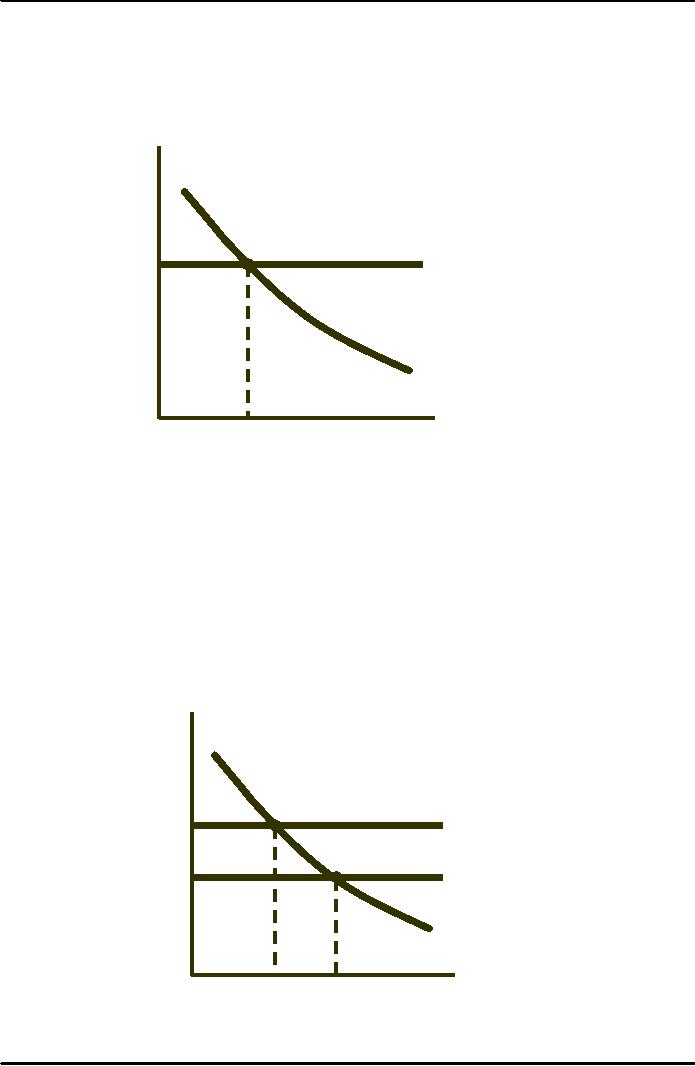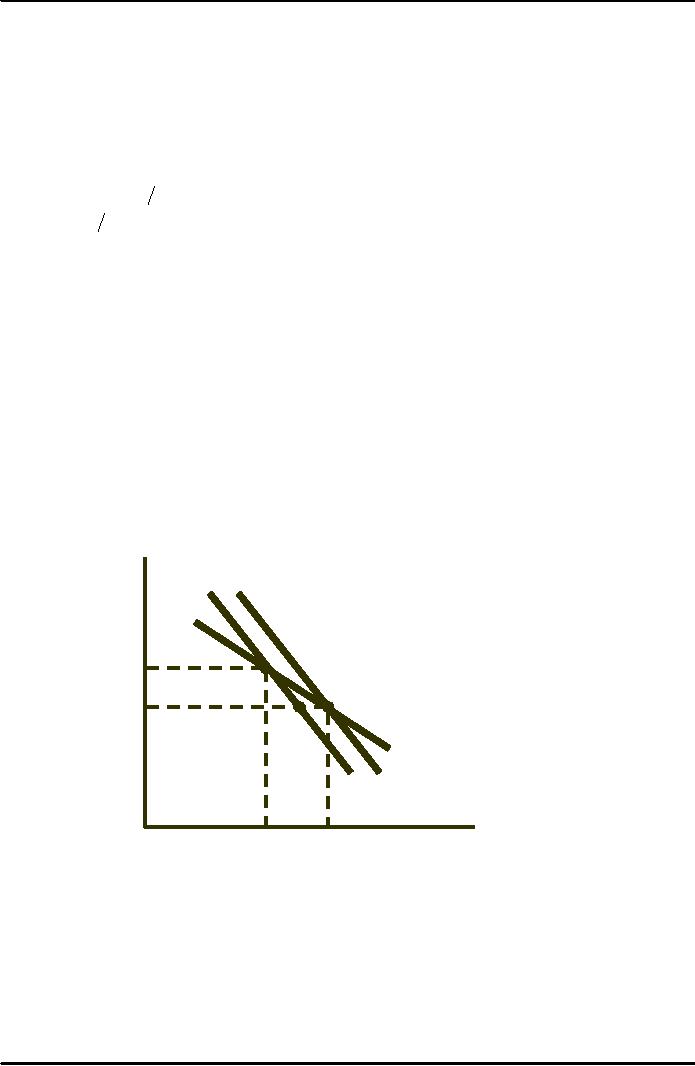 |
COMPETITIVE FACTOR MARKETS:Marginal Revenue Product |
| << Competition Versus Collusion:The Prisoners’ Dilemma, Implications of the Prisoners |
| Competitive Factor Markets:The Demand for Jet Fuel >> |

Microeconomics
ECO402
VU
�
�
Lesson
42
COMPETITIVE
FACTOR MARKETS
Characteristics
1)
Large number of sellers of
the factor of
production
2)
Large number of buyers of
the factor of
production
3)
The buyers and sellers of
the factor of production are
price takers
Demand
for a Factor Input When
Only One Input Is
Variable
Demand for
factor inputs is a derived
demand...
�
Derived
from factor cost and
output demand
Assume
�
Two
inputs: Capital (K)
and Labor (L)
�
Cost of K is
r
and
the cost of labor is
w
�
K is fixed
and L is variable
Problem
�
How much
labor to hire?
Measuring
the Value of a Worker's
Output
�
Marginal
Revenue Product of Labor
(MRPL)
�
MRPL =
(MPL)(MR)
Assume
perfect competition in the
product market
�
Then MR =
P
Question
�
What will
happen to the value of MRPL when
more workers are
hired?
Marginal
Revenue Product
Wages
($
per
Competitive
Output Market (P
= MR)
hour)
MRPL =
MPLx P
Monopolistic
Output
MRPL =
MPL x MR
Market
Hours
of Work
Choosing
the profit-maximizing amount of
labor
�
If MRPL >
w
(the
marginal cost of hiring a
worker): hire the
worker
193

Microeconomics
ECO402
VU
�
If MRPL <
w:
hire
less labor
�
If MRPL =
w:
profit maximizing amount of
labor
Hiring
by a Firm in the Labor
Market (with Capital
Fixed)
In
a competitive labor market,
a
firm
faces a perfectly elastic
supply of labor
Price
and
can hire as many workers as
it wants at w*.
of
Labor
The
profit maximizing firm
will
hire
L* units
of labor at the point
where
the marginal revenue
product
of
labor is equal to the wage
rate.
w
S
Why
not hire fewer
or
more workers than L*.
MRPL =
L
Quantity
of Labor
Competitive
Factor Markets
Demand
for a Factor Input When
Only One Input Is
Variable
If the
market supply of labor
increased relative to demand
(baby boomers or
female
entry),
a surplus of labor would
exist and the wage
rate would fall.
Question
�
How would
this impact the quantity
demanded for labor?
A
Shift in the Supply of
Labor
Price
of
Labor
S1
w1
w2
S2
MRPL = DL
Quantity
of Labor
L1
L2
194

Microeconomics
ECO402
VU
Comparing
Input and Output
Markets
MRP
L =
( MP
L )( MR)
and
at profit maximizing
number
of workers MRP L =
w
(MP
L )( MR) =
w
MR
=
w
MP
L
w
MP
L =
MC of
production
In both
markets, input and output
choices occur where MR =
MC
�
MR from
the sale of the
output
�
MC from
the purchase of the
input
Demand
for a Factor Input When
Several Inputs Are
Variable
Scenario
�
Producing farm
equipment with two variable
inputs:
Labor
Assembly-line
machinery
�
Assume the
wage rate falls
Question
�
How will
the decrease in the wage
rate impact the demand
for labor?
Firm's
Demand Curve for Labor
(with Variable
Capital)
When
two or more inputs
are
Wages
variable,
a firm's demand for
one
($
per
input
depends on the
marginal
hour)
revenue
product of both
inputs.
When
the wage rate is $20,
A
represents
one point on the
firm's
demand
for labor curve.
A
When
the wage rate falls to
$15, the
20
MRP
curve shifts, generating a
new
C
point
C on the firm's demand
for
labor
curve. Thus A and C
are
15
on
the demand for labor
curve, but
B
B
is not.
D
10
MRPL
MRPL
5
0
40
80
120
160
Hours
of Work
195
Table of Contents:
- ECONOMICS:Themes of Microeconomics, Theories and Models
- Economics: Another Perspective, Factors of Production
- REAL VERSUS NOMINAL PRICES:SUPPLY AND DEMAND, The Demand Curve
- Changes in Market Equilibrium:Market for College Education
- Elasticities of supply and demand:The Demand for Gasoline
- Consumer Behavior:Consumer Preferences, Indifference curves
- CONSUMER PREFERENCES:Budget Constraints, Consumer Choice
- Note it is repeated:Consumer Preferences, Revealed Preferences
- MARGINAL UTILITY AND CONSUMER CHOICE:COST-OF-LIVING INDEXES
- Review of Consumer Equilibrium:INDIVIDUAL DEMAND, An Inferior Good
- Income & Substitution Effects:Determining the Market Demand Curve
- The Aggregate Demand For Wheat:NETWORK EXTERNALITIES
- Describing Risk:Unequal Probability Outcomes
- PREFERENCES TOWARD RISK:Risk Premium, Indifference Curve
- PREFERENCES TOWARD RISK:Reducing Risk, The Demand for Risky Assets
- The Technology of Production:Production Function for Food
- Production with Two Variable Inputs:Returns to Scale
- Measuring Cost: Which Costs Matter?:Cost in the Short Run
- A Firm’s Short-Run Costs ($):The Effect of Effluent Fees on Firms’ Input Choices
- Cost in the Long Run:Long-Run Cost with Economies & Diseconomies of Scale
- Production with Two Outputs--Economies of Scope:Cubic Cost Function
- Perfectly Competitive Markets:Choosing Output in Short Run
- A Competitive Firm Incurring Losses:Industry Supply in Short Run
- Elasticity of Market Supply:Producer Surplus for a Market
- Elasticity of Market Supply:Long-Run Competitive Equilibrium
- Elasticity of Market Supply:The Industry’s Long-Run Supply Curve
- Elasticity of Market Supply:Welfare loss if price is held below market-clearing level
- Price Supports:Supply Restrictions, Import Quotas and Tariffs
- The Sugar Quota:The Impact of a Tax or Subsidy, Subsidy
- Perfect Competition:Total, Marginal, and Average Revenue
- Perfect Competition:Effect of Excise Tax on Monopolist
- Monopoly:Elasticity of Demand and Price Markup, Sources of Monopoly Power
- The Social Costs of Monopoly Power:Price Regulation, Monopsony
- Monopsony Power:Pricing With Market Power, Capturing Consumer Surplus
- Monopsony Power:THE ECONOMICS OF COUPONS AND REBATES
- Airline Fares:Elasticities of Demand for Air Travel, The Two-Part Tariff
- Bundling:Consumption Decisions When Products are Bundled
- Bundling:Mixed Versus Pure Bundling, Effects of Advertising
- MONOPOLISTIC COMPETITION:Monopolistic Competition in the Market for Colas and Coffee
- OLIGOPOLY:Duopoly Example, Price Competition
- Competition Versus Collusion:The Prisoners’ Dilemma, Implications of the Prisoners
- COMPETITIVE FACTOR MARKETS:Marginal Revenue Product
- Competitive Factor Markets:The Demand for Jet Fuel
- Equilibrium in a Competitive Factor Market:Labor Market Equilibrium
- Factor Markets with Monopoly Power:Monopoly Power of Sellers of Labor